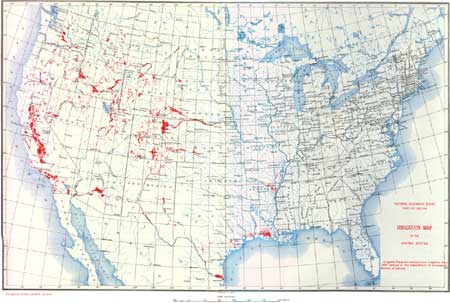![]()
MENU
SECTION I
SECTION II
History
Needs
Geography
Historic Sites
![]() Competitors
Competitors
Economic Aspects
SECTION III
Federal Lands
State and Interstate
Local
SECTION IV
Division of Responsibility
Local
State
Federal
Circulation
SECTION V
Recreational Use of Land in the United States
SECTION II
RECREATIONAL RESOURCES AND HUMAN REQUIREMENTS
5. SOME COMPETITORS OF RECREATIONAL LAND USE
Artificial Stream Control
The construction of reservoirs for irrigation and power has a direct bearing upon the recreational question. The possible flooding of historical and archeological sites is noted elsewhere in this report. The flooding of recreational areas possessing great scenic beauty (for instance, Hetch Hetchy Reservoir in Yosemite National Park) has frequently been a matter of rather general concern and, in reality, a matter of national importance.

(click on image for an enlargement in a new window)
In extremely arid regions reservoirs have in some places added to the recreational value of a region. They have produced a fairly constant body of water where only sporadic torrents existed before. But in general the recreational values of reservoirs have been overestimated, chiefly because the frequent change of shore line leaves an unsightly, unusable "no-man's land" between high and low water, wherein all vegetation dies and the accumulating litter decays.
Considering this factor, there is reason to question the wisdom of the construction of reservoirs in areas, such as the upper portions of the Kings River Canyon, which are outstanding because of the value of their wilderness type of recreation.
Compensatory artificial control of streams, designed to counteract the sterility of the stream caused by drainage or overgrazing, is, of course, of recreational value. Much of value may be accomplished also in producing more abundant aquatic habitats, particularly for fish, throughout the streams of the country. Fish ladders should be provided wherever possible in connection with the construction of dams. For example, this need is a vital one in New Hampshire, where few fish ladders have been provided, thus contributing to the impairment of a great fishing resource.
Conclusions
It becomes evident that <>area is not a proper unit of measurement for recreational resources. Recreational resources permeate the whole mosaic of our national resources. Recreational use of national resources, therefore, must be correlated with other forms of use, except within areas of primary recreational value. In these latter, no competing use of the resource can be permitted.
For example, if all the Nation's waters could be freed from artificial pollution, the recreational resource liberated would probably be greater than the combined resources of parks.
Any analysis of such forms of land use and abuse and their relation to recreational resources suggests very strongly the need of a Federal agency whose responsibility it should be to call attention to recreational resources, particularly when other uses of such resources would destroy, needlessly, their recreational value.
Last Modified: Fri, Sep. 5, 2003 10:32:22 am PDT
http://www.cr.nps.gov/history/online_books/recreational_use/chap2-5c.htm
![]()

 Top
Top